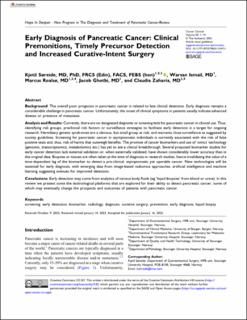| dc.contributor.author | Søreide, Kjetil | |
| dc.contributor.author | Ismail, Warsan | |
| dc.contributor.author | Roalsø, Marcus Thomas Thor | |
| dc.contributor.author | Ghotbi, Jacob | |
| dc.contributor.author | Zaharia, Claudia | |
| dc.date.accessioned | 2023-06-27T11:35:16Z | |
| dc.date.available | 2023-06-27T11:35:16Z | |
| dc.date.created | 2023-04-02T13:12:47Z | |
| dc.date.issued | 2023 | |
| dc.identifier.issn | 1073-2748 | |
| dc.identifier.uri | https://hdl.handle.net/11250/3073478 | |
| dc.description.abstract | Background: The overall poor prognosis in pancreatic cancer is related to late clinical detection. Early diagnosis remains a considerable challenge in pancreatic cancer. Unfortunately, the onset of clinical symptoms in patients usually indicate advanced disease or presence of metastasis.
Analysis and Results: Currently, there are no designated diagnostic or screening tests for pancreatic cancer in clinical use. Thus, identifying risk groups, preclinical risk factors or surveillance strategies to facilitate early detection is a target for ongoing research. Hereditary genetic syndromes are a obvious, but small group at risk, and warrants close surveillance as suggested by society guidelines. Screening for pancreatic cancer in asymptomatic individuals is currently associated with the risk of false positive tests and, thus, risk of harms that outweigh benefits. The promise of cancer biomarkers and use of ‘omics’ technology (genomic, transcriptomics, metabolomics etc.) has yet to see a clinical breakthrough. Several proposed biomarker studies for early cancer detection lack external validation or, when externally validated, have shown considerably lower accuracy than in the original data. Biopsies or tissues are often taken at the time of diagnosis in research studies, hence invalidating the value of a time-dependent lag of the biomarker to detect a pre-clinical, asymptomatic yet operable cancer. New technologies will be essential for early diagnosis, with emerging data from image-based radiomics approaches, artificial intelligence and machine learning suggesting avenues for improved detection.
Conclusions: Early detection may come from analytics of various body fluids (eg ‘liquid biopsies’ from blood or urine). In this review we present some the technological platforms that are explored for their ability to detect pancreatic cancer, some of which may eventually change the prospects and outcomes of patients with pancreatic cancer. | en_US |
| dc.language.iso | eng | en_US |
| dc.publisher | SAGE | en_US |
| dc.rights | Navngivelse 4.0 Internasjonal | * |
| dc.rights.uri | http://creativecommons.org/licenses/by/4.0/deed.no | * |
| dc.title | Early Diagnosis of Pancreatic Cancer: Clinical Premonitions, Timely Precursor Detection and Increased Curative-Intent Surgery | en_US |
| dc.type | Journal article | en_US |
| dc.type | Peer reviewed | en_US |
| dc.description.version | publishedVersion | en_US |
| dc.rights.holder | Copyright 2023 the authors | en_US |
| cristin.ispublished | true | |
| cristin.fulltext | original | |
| cristin.qualitycode | 1 | |
| dc.identifier.doi | 10.1177/10732748231154711 | |
| dc.identifier.cristin | 2139105 | |
| dc.source.journal | Cancer Control | en_US |
| dc.identifier.citation | Cancer Control. 2023, 30. | en_US |
| dc.source.volume | 30 | en_US |

